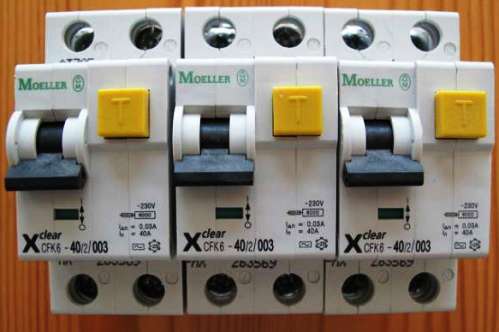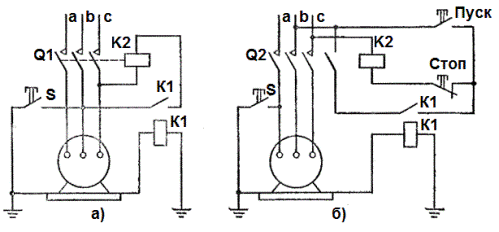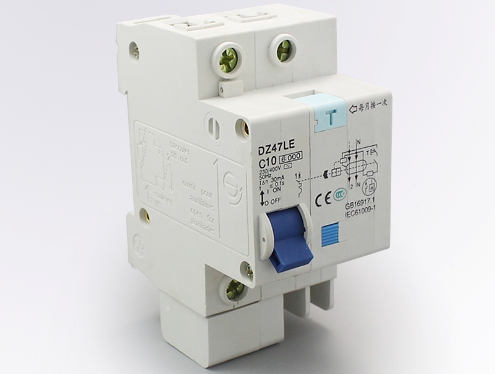Protective shutdown in electrical installations
Protective shutdown is understood as rapid, for a time no longer than 200 ms, automatic shutdown from the power source of all phases of the consumer or part of the electrical wiring, if the insulation is damaged or there is another emergency situation that threatens a person with an electric shock .
Protective automatic shutdown of the power supply — automatic opening of the circuit of one or more phase conductors (and, if necessary, the neutral working conductor), carried out for the purpose of electrical safety.
Protective disconnection can be both the only and main protection measure, and an additional measure to the grounding and neutralization networks in connection with electrical installations with an operating voltage of up to 1000 volts.

Designation of protective shutdown - ensuring electrical safety, which is achieved by limiting the time of exposure of a person to dangerous current.
Safe shutdown - high-speed protection that ensures automatic shutdown of the electrical installation in case of danger of electric shock in it.This hazard can occur when:
-
short circuit of a phase to the body of electrical equipment;
-
with a decrease in the insulation resistance of the phases relative to the ground below a certain limit;
-
the appearance of higher voltage in the network;
-
touching a live part that is live.
In these cases, some electrical parameters change in the network: for example, the case to ground voltage, the phase to ground voltage, the zero sequence voltage, etc. Each of these parameters can be changed, or rather, the change to a certain limit, at which there is a danger of injury to a person from electric current, can serve as an impulse that triggers the operation of a protective-disconnecting device, that is, automatic shutdown of a dangerous section from the network.
To the current devices, a protective shutdown fox of four types of electrical installations is usually applied:
-
Mobile installations with an isolated neutral (under such conditions, in principle, the construction of a full-fledged grounding device is problematic). Protective disconnection is then used either together with earthing or as an independent protective measure.
-
Stationary installations with isolated neutral (where it is necessary to protect electrical machines with which people work).
-
Mobile and stationary installations with a neutral of any type, where there is a high degree of danger of electric shock, or if the installation is operated in an explosive environment.
-
Fixed installations with a solid earthed neutral in some high power users and in remote users where earthing is insufficient for protection or where it is not sufficiently effective as a protective measure do not provide sufficient multiplicity of phase to earth current.
To implement the trip protection function, use special residual current devices. Their schemes may differ, the designs depend on the characteristics of the protected electrical installation, on the nature of the load, on the mode of neutral grounding, etc.
Residual current device — a set of individual elements that react to a change in any parameter of the electrical network and give a signal to turn off the circuit breaker. The residual current device, depending on the parameter it responds to, can be attributed to one type or another, including the types of devices that respond to frame voltage to earth, earth fault current, phase to earth voltage, zero sequence voltage, zero sequence current, operating current, etc.
A specially fitted protective relay can be used here, which is designed in the same way as the highly sensitive open contact voltage relays that are included in the supply circuit of a magnetic starter, say an electric motor.
The purpose of a protective shutdown is to apply a set of protections with a single device or some of its following types:
-
from single-phase earth faults or to electrical equipment normally isolated from voltage;
-
from incomplete short circuits, when the reduction of the insulation of one of the phases creates a risk of injury to a person;
-
from injury when a person touches one of the phases of the electrical equipment if the touch occurs in the protective zone of the device.

An example of this is a simple residual current device based on a voltage relay. The relay coil is connected between the enclosure of the protected equipment and the earthing switch.
In conditions where the relay coil has a resistance that is much higher than that of the auxiliary earth electrode located outside the protective earth splash zone, the relay coil K1 will be energized from the box to earth.
Then, at the moment of emergency breaking of the case, this voltage will be greater than the relay trip voltage and the relay will operate, closing the breaker Q1 or energizing the supply circuit of the magnetic starter Q2 by tripping.
Another option for a simple residual current device for electrical installations is current relay (overcurrent relay). Its coil is included in the break of the zeroing wire, therefore the contacts open the power circuit of the magnetic starter coil in the same way, if the power circuit of the circuit breaker coil is closed. By the way, instead of winding the relay, you can sometimes use the circuit breaker winding as an overcurrent relay.
When the residual current device is put into service, it is mandatory to check it: scheduled full and partial checks are carried out to ensure that the device works reliably and that interruptions occur when necessary.
Once every three years, a full planned inspection is carried out, often together with the repair of connected circuits of electrical installations.The inspection also includes insulation tests, checking of protective settings, tests of protective devices and a general inspection of the apparatus and all connections.
As for partial inspections, they are carried out from time to time, depending on the specific conditions, but include: insulation inspection, general inspection, operational protection tests. If the protective device does not work quite correctly, a more thorough check is carried out using a special algorithm.
In our time, protective disconnection is most widespread in electrical installations used in networks with a voltage of up to 1 kV with a grounded or isolated neutral.
Electrical installations with a voltage of up to 1 kV in residential, public and industrial buildings and outdoor installations must, as a rule, be supplied from a source with a solidly grounded neutral with a TN system… To protect against electric shock in the event of indirect contact, such electrical installations must be automatically disconnected from the power supply.
When carrying out automatic disconnection of electrical installations with a voltage of up to 1 kV, all exposed conductive parts must be connected to the neutral earthed neutral of the supply if a TN system is used, and earthed if IT or TT systems are used. In this case, the characteristics of the protective devices and the parameters of the protective conductors must be coordinated to ensure the normalized time of disconnection of the damaged circuit from the protective switching device in accordance with the nominal phase voltage of the supply network.
Protection is in progress special residual current device (RCD), which, operating in standby mode, continuously monitors the conditions of a person's electric shock.

RCDs are used in electrical installations up to 1 kV:
-
in mobile e-mail installations with an isolated neutral (especially if it is difficult to create a grounding device. It can be used both as an independent protection and in combination with grounding);
-
in fixed electrical installations with an isolated neutral for the protection of hand-held electrical machines as the sole protection and in addition to others;
-
in conditions of increased risk of electric shock and explosion in stationary and mobile electrical installations with different neutral modes;
-
in stationary electrical installations with a firmly grounded neutral at individual remote consumers of electrical energy and a consumer with a high rated power, where the protection by earthing is not sufficiently effective.
The principle of operation of the RCD is that it constantly monitors the input signal and compares it with a predetermined value (set value). If the input signal exceeds the set value, the device is activated and disconnects the protected electrical installation from the network. As input signals of residual current devices, various parameters of electrical networks are used, which carry information about the conditions of electric shock to a person.
See also: Circuit breaker, circuit breaker, RCD — what's the difference?
